 In an interview with the Yorkshire Post, Mark Carney, Governor of the Bank of England, said that under current circumstances he did not feel that further quantitative easing was justified. He said:
In an interview with the Yorkshire Post, Mark Carney, Governor of the Bank of England, said that under current circumstances he did not feel that further quantitative easing was justified. He said:
My personal view is, given the recovery has strengthened and broadened, I don’t see a case for quantitative easing and I have not supported it.
In response to his speech, the pound strengthened against the dollar. It appreciated by just over 1 cent, or 0.7%. But why should the likelihood of no further quantitative easing lead to a strengthening of the pound?
The answer lies with people’s anticipation of future interest rates. If there is no further increase in money supply through QE, interest rates are likely to rise as the economy recovers and thus the demand for money rises. 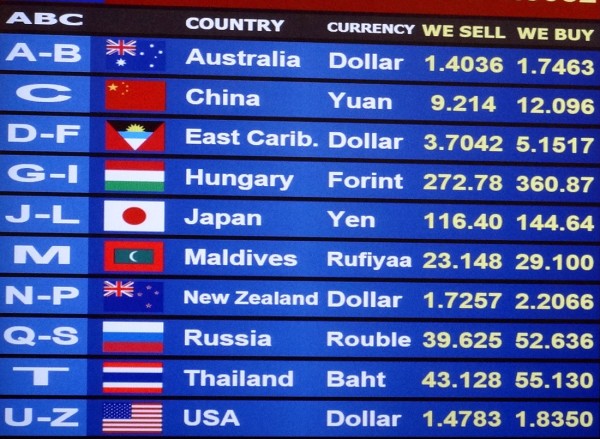 A rise in interest rates, in turn, is likely to lead to an inflow of finance into the country, thereby boosting the financial account of the balance of payments. The increased demand for sterling will tend to drive up the exchange rate.
A rise in interest rates, in turn, is likely to lead to an inflow of finance into the country, thereby boosting the financial account of the balance of payments. The increased demand for sterling will tend to drive up the exchange rate.
However, an increase in aggregate demand will result in an increase in imports and a likely increase in the balance of trade deficit. Indeed, in July (the latest figures available) the balance of trade deficit rose to £3.085bn from £1.256bn in June. As recovery continues, the balance of trade deficit is likely to deteriorate further. Other things being equal, this would lead to a depreciation of the pound.
So if the pound appreciates, this suggests that the effect on the financial account is bigger than the effect on the current account – or is anticipated to be so. In fact, given the huge volumes of short-term capital that move across the foreign exchanges each day, financial account effects of interest rate changes – actual or anticipated – generally outweigh current account effects.
Articles
Yorkshire can reap benefits from turnaround says Mark Carney Yorkshire Post (27/9/13)
Sterling Jumps as BOE Chief Signals No More Bond Buying Wall Street Journal, Nick Cawley and Jason Douglas (27/9/13)
Carney’s Northern Exposure Sends Sterling Soaring Wall Street Journal, David Cottle (27/9/13)
Pound Gains as Carney Sees No Case for QE, Confidence Improves Bloomberg, Anchalee Worrachate & David Goodman (28/9/13)
Exchange Rate Bounces as Strong UK Data Supports Sterling FCF (Future Currency Forecast), Laura Parsons (30/9/13)
Currency briefing: What if the pound sterling has been overbought? iNVEZZ, Tsvyata Petkova (30/9/13)
Pound rises after Carney rejects increasing QE BBC News (27/9/13)
Pound Rises for Fourth Day Versus Euro on Housing, Mortgage Data Bloomberg, Emma Charlton (30/9/13)
Data
$ per £ exchange rate (latest month) XE (You can access other periods and currencies)
Effective exchange rate indices (nominal and real) Bank for International Settlements
Balance of Payments, Q2 2013 Dataset ONS
Questions
- Explain how quantitative easing affects exchange rates.
- What is happening concerning quantitative easing in the USA? How is this likely to affect the exchange rate of the US dollar to sterling; other currencies to sterling?
- Why may an increase in the balance of trade deficit lead directly to an appreciation of the exchange rate?
- Why is an anticipation of a policy change likely to have more of an effect on exchange rates than the actual policy change itself? Why, indeed, may a policy change have the reverse effect once it is implemented?
- Under what circumstances may speculation against exchange rate changes be (a) stabilising; (b) destabilising?
- How is quantitative easing (or an anticipation of it) likely to affect each of the main components of the current and financial accounts of the balance of payments?
- For what reasons might sterling have been ‘overbought’ and hence be overvalued?
- What is meant by the real exchange rate (REER)? Why may reference to the REER suggest that sterling is not currently overvalued?
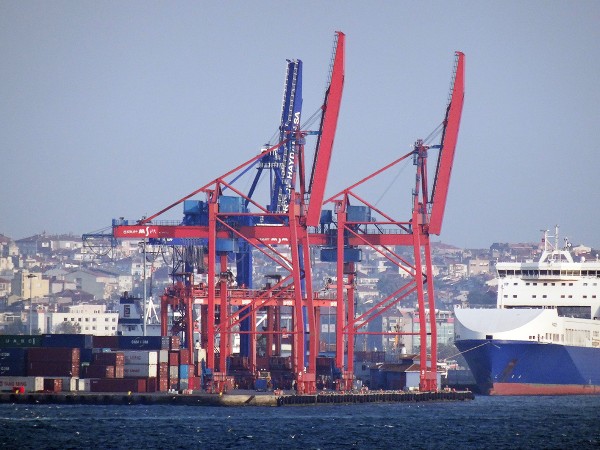 Turkey has experienced rapid economic growth in recent years and has attracted large inflows of foreign capital. The chart below illustrates how growth in real GDP in Turkey in most years since 2000 has considerably exceeded that in the OECD as a whole (click here for a PowerPoint). As you can see from the chart, growth in Turkey over the period has averaged 4.5%, while that in the OECD has averaged just 1.8%.
Turkey has experienced rapid economic growth in recent years and has attracted large inflows of foreign capital. The chart below illustrates how growth in real GDP in Turkey in most years since 2000 has considerably exceeded that in the OECD as a whole (click here for a PowerPoint). As you can see from the chart, growth in Turkey over the period has averaged 4.5%, while that in the OECD has averaged just 1.8%.
Indeed, Turkish growth has been compared with that of the BRICs (Brazil, Russia, India and China). However, like the BRICs, Turkey has been experiencing slowing growth in the past few months. Indeed, the slowdown has been especially marked in Turkey.
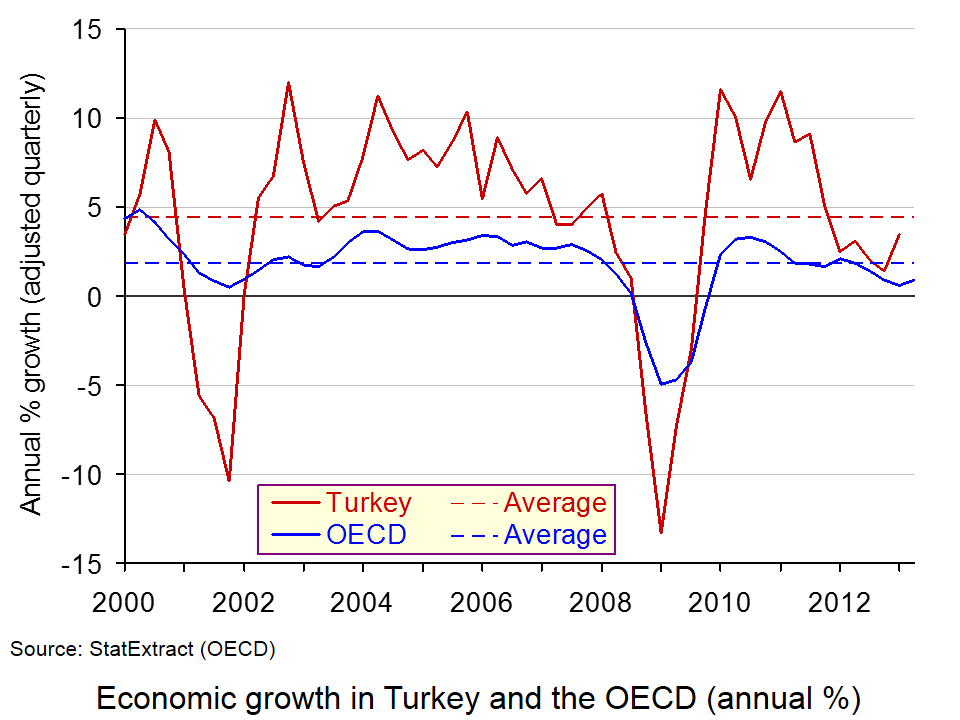 In recent years Turkey has benefited from large inflows of foreign capital. Partly these were direct investment flows, encouraged by a large and rapidly growing internal market, boosted by a rapid expansion of consumer credit, and also by a growing export sector. But to a large extent, especially in recent years, there has been a large rise in portfolio and other investment inflows. This has been encouraged by a large increase in global money supply resulting from policies of quantitative easing in the USA and other developed countries.
In recent years Turkey has benefited from large inflows of foreign capital. Partly these were direct investment flows, encouraged by a large and rapidly growing internal market, boosted by a rapid expansion of consumer credit, and also by a growing export sector. But to a large extent, especially in recent years, there has been a large rise in portfolio and other investment inflows. This has been encouraged by a large increase in global money supply resulting from policies of quantitative easing in the USA and other developed countries.
 But the economic climate has changed. First investors have become worried about the conflict in Syria escalating and this impacting on Turkey. Second Turkey’s large financial account surpluses have allowed it to run large current account deficits and have maintained a high exchange rate. Third the tapering off and possible reversal of quantitative easing have led to recent outflows of finance from various countries perceived as being vulnerable, including Turkey.
But the economic climate has changed. First investors have become worried about the conflict in Syria escalating and this impacting on Turkey. Second Turkey’s large financial account surpluses have allowed it to run large current account deficits and have maintained a high exchange rate. Third the tapering off and possible reversal of quantitative easing have led to recent outflows of finance from various countries perceived as being vulnerable, including Turkey.
The effect of this has been a depreciation of the Turkish lira and upward pressure on inflation. The lira has fallen by 14% since the beginning of 2013 and by nearly 7% since the beginning of August alone.
The question is whether the supply side of the Turkish economy has become robust enough to allow the country to ride out its current difficulties. Will foreign investors have sufficient faith in the long-term potential of the Turkish economy to continue with direct investment, even if short-term financial inflows diminish?
Articles
Turkey’s economy faces uncertainties amid possible military intervention in Syria Xinhua, Fu Peng (29/8/13)
Turkey may cut 2014 growth target to 4% Turkish Daily News (8/9/13)
Turkish lira at record low, threatening growth Daily News Egypt (7/9/13)
Turkish lira may need higher interest rates to escape emerging markets rout Reuters, Sujata Rao and Seda Sezer (20/8/13)
Turkey Economic Crisis: Crises from Both Sides Wealth Daily, Joseph Cafariello (9/8/13)
Western financial prescription has made Turkey ill The Observer, Heather Stewart (1/9/13)
Turkish Deputy PM Babacan calm amid economic fluctuations Turkish Daily News (8/9/13)
 The Fragile Five BBC News, Linda Yueh (26/9/13)
The Fragile Five BBC News, Linda Yueh (26/9/13)
Data
Economic growth rates (annual) for Turkey, Brazil, Russia, India and China: 2000–13 IMF Economic Outlook Database (April 2013)
Quarterly growth rates of real GDP for OECD countries and selected other countries and groups of countries OECD StatExtracts
Turkey and the IMF IMF
Turkey: data World Bank
Links to Turkish Official Statistics Offstats
Country statistical profile: Turkey OECD Country Statistical Profiles
Spot exchange rate, Turkish Lira into Dollar Bank of England
Questions
- Why has the Turkish economy experienced such rapid growth in recent years and especially from 2010 to 2012?
- Why has Turkish growth slowed over the past year?
- Why has “Western financial prescription made Turkey ill”
- Why has the Turkish lira depreciated? What has determined the size of this depreciation?
- What are the beneficial and adverse effects of this depreciation?
- Why must any surplus on the combined financial and capital accounts of the balance of payments be matched by a corresponding deficit on the current account?
- How is a tapering off of quantitative easing likely to impact on developing countries? What will determine the size of this impact?
- Istanbul has lost its bid to host the 2020 Olympic Games? How is this likely to affect the Turkish economy?
 The US dollar has been used as the international currency for the majority of international trade. Around 85% of foreign-exchange transactions are trades between US dollars and other currencies. As the first article below, from the Wall St Journal, states:
The US dollar has been used as the international currency for the majority of international trade. Around 85% of foreign-exchange transactions are trades between US dollars and other currencies. As the first article below, from the Wall St Journal, states:
When a South Korean wine wholesaler wants to import Chilean cabernet, the Korean importer buys US dollars, not pesos, with which to pay the Chilean exporter. Indeed, the dollar is virtually the exclusive vehicle for foreign-exchange transactions between Chile and Korea, despite the fact that less than 20% of the merchandise trade of both countries is with the US.
… The dollar is the currency of denomination of half of all international debt securities. More than 60% of the foreign reserves of central banks and governments are in dollars.
But things are gradually changing as countries increasingly by-pass the dollar. Several countries have reached agreements with China to allow companies to exchange their currencies directly in so-called ‘currency swap‘ arrangements (see also). These include Japan, Australia, the UK, France/the eurozone, Argentina, Brazil, South Korea, Chile and Russia. But while these currency swap arrangements apply to current account transactions, there are still considerable controls of currency movements on China’s capital and financial accounts.
So what will be the implications for the USA and for China? What will be the impact on currency and bonds markets? The following articles explore the issues.
Why the Dollar’s Reign Is Near an End Wall Street Journal, Barry Eichengreen (1/3/11)
Beijing Continues Inexorable Push for Internationalisation of the Renminbi iNVEZZ, Alice Young (22/4/13)
RMB: Advance of the renminbi Emerging Markets, Elliot Wilson (4/5/13)
China’s new leaders to quicken yuan reform, but caution remains Reuters, Kevin Yao and Heng Xie (7/5/13)
Japan, China to launch direct yen-yuan trade on June 1 Reuters, Tetsushi Kajimoto (29/5/12)
China and Japan to start direct yen-yuan trade in June BBC News (29/5/12)
BOE Plans to Sign Yuan Currency Swap Deal With China Bloomberg, Fergal O’Brien & Svenja O’Donnell (22/2/13)
Bank of England, PBOC close to RMB/GBP swap agreement Emerging Markets (22/2/13)
China and Brazil sign $30bn currency swap agreement BBC News (27/3/13)
China, Brazil sign trade, currency deal before BRICS summit Reuters, Agnieszka Flak and Marina Lopes (26/3/13)
Direct trading to boost global use of yuan China Daily, Wei Tian (10/4/13)
Paris vies to be yuan hub China Daily, Li Xiang (19/4/13)
France plans currency swap line with China: paper Reuters (12/4/13)
Yuan Replaces the Dollar in China’s Dealings With France, Britain, Australia, as the War-Debt Continues to Destroy US Currency Al-Jazeerah (6/5/13)
China Takes Another Stab At The Dollar, Launches Currency Swap Line With France ZeroHedge, Tyler Durden (13/4/13)
Questions
- What are the ‘three pillars’ that have supported the dollar’s dominance?
- What is changing in the global economy to undermine this dominance?
- What will be the impact on the US government and US companies?
- What steps has China taken to ‘internationalise’ the renminbi (denominated in yuan)?
- Is the role of the euro likely to increase or decrease as an internationally held and used currency?
- What dangers are there for investors in holding all their wealth in dollar-denominated assets?
- Why may the increasing internationalisation of the euro and renminbi lead to less volatility between them and the dollar?
- How will the growing internationalisation of the euro and renminbi benefit eurozone and Chinese banks and internationally trading companies?
- What more does China need to do before the renminbi can be regarded as a truly global currency?
 The UK economy shrank by 0.3 per cent in the final quarter of 2012. A significant factor in the fall was the UK’s balance of trade, which measures the difference between the value of goods and services exported and those imported. The balance of trade deficit rose in 2012 to £36.2 billion or 2.3 per cent of GDP. If we measure only the balance in goods, the deficit was an eye-watering £106.3 billion – a record high for the UK. The balance of trade remains a drag on British growth.
The UK economy shrank by 0.3 per cent in the final quarter of 2012. A significant factor in the fall was the UK’s balance of trade, which measures the difference between the value of goods and services exported and those imported. The balance of trade deficit rose in 2012 to £36.2 billion or 2.3 per cent of GDP. If we measure only the balance in goods, the deficit was an eye-watering £106.3 billion – a record high for the UK. The balance of trade remains a drag on British growth.
The balance of payments is a record all the flows of money between a country’s residents and the rest of the world. Inflows represent credits on the balance of payments while outflows represent debits. We focus here on perhaps the best-known component of the overall balance of payments: the current account. The current account comprises three separate accounts. First, there is the balance of trade (in goods and services). It records payments for exports (X) and imports (M). Second, there is net income flows. Net income flows are flows of money between countries in the form of wages, profits and interest. Finally, there is current transfers. Current transfers are transfers of money between countries for the purpose of consumption, including, for instance, a transfer payment by the British government to overseas organisations.
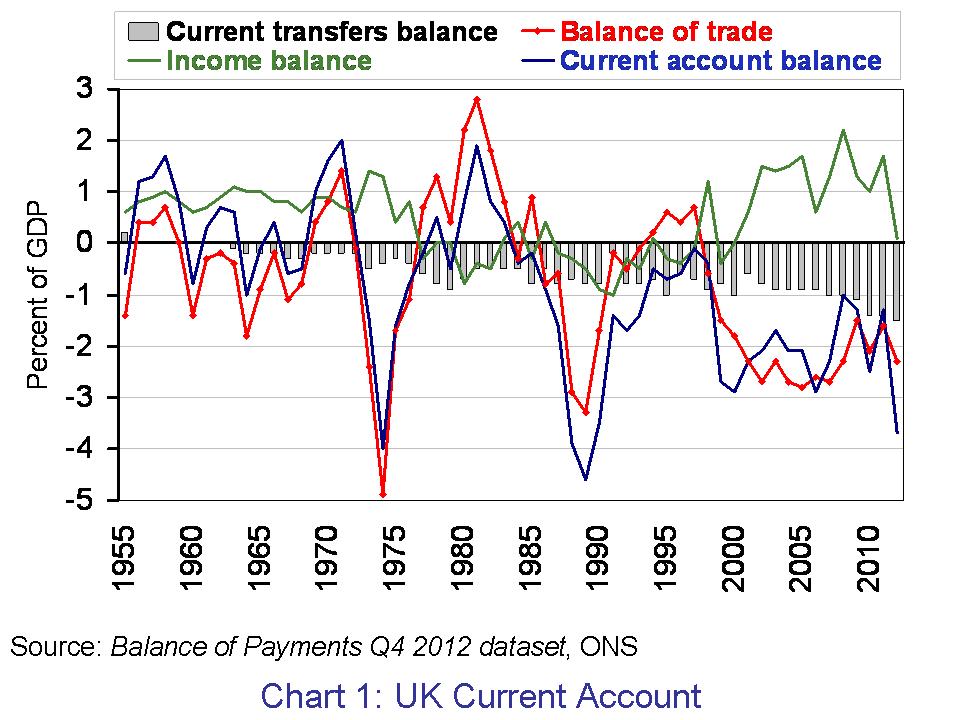
Chart 1 presents the UK’s current account. It is based on data from Balance of Payments Q4 2012 dataset published by the Office for National Statistics. The current account deficit in 2012 was £57.7 billion (up from a deficit of £20.2 billion in 2011). This is the equivalent to 3.7 per cent of GDP (up from a deficit of 1.3 per cent in 2011) and the highest current account deficit since 1989 when it reached 4.6 per cent of GDP. Back in 1989, the UK economy was growing by 2.6 per cent having grown by 5.6 per cent in 1988. In 2012, the UK economy grew by just 0.3 per cent following growth of 1.0 per cent in 2011. The mean average rate growth of the UK economy since 1950 is 2.6 per cent. (Click here for a PowerPoint of the chart.)
The net income balance, which while remaining in surplus, worsened significantly. From a surplus of £25.9 billion (1.7 per cent of GDP) in 2011, it fell to a surplus of just £1.6 billion (0.1 per cent of GDP) in 2012. This is largely attributable to a decline in the surplus of direct investment income and, in particular, the earnings abroad of non-bank private corporations. Meanwhile, the deficit on current transfers in 2012 was £23.1 billion, up from £22.0 billion in 2011. This is the highest on record. The current transfers deficit with EU institutions rose in 2012 to £10.5 billion, up by £1 billion on 2011.
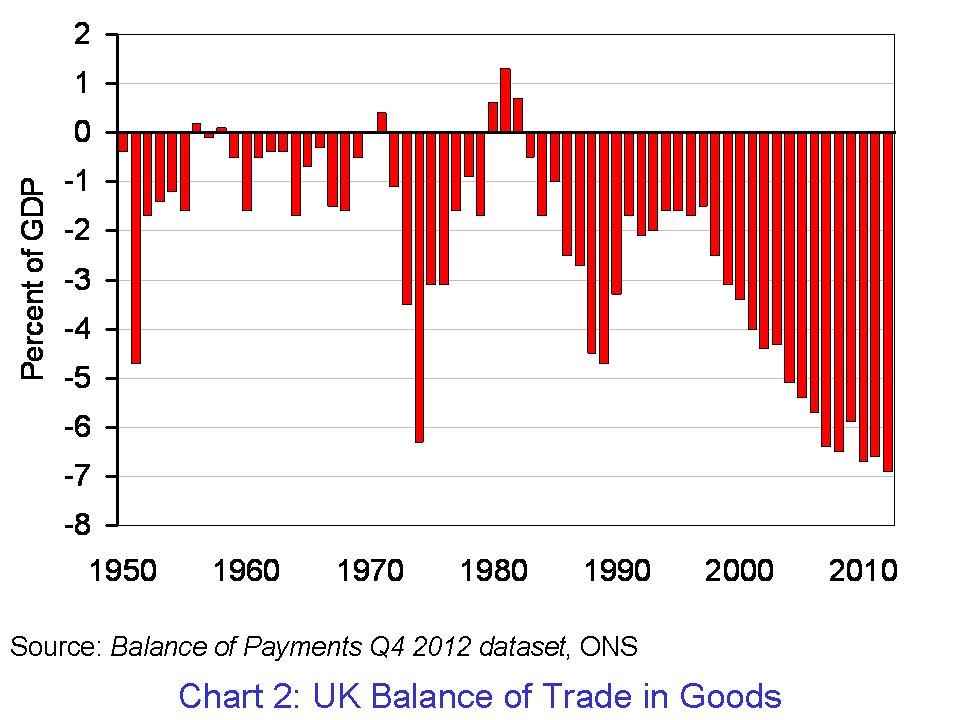
The balance of trade deficit too worsened in 2012. The deficit rose from £24.1 billion in 2011 (1.6 per cent of GDP) to £36.2 billion in 2012 (2.3 per cent of GDP). The persistent balance of trade deficit continues to occur despite a persistent surplus on the trade in services. In 2012, the balance of trade surplus in services was £70 billion (4.6 per cent of GDP). As Chart 2 shows, the UK now has a record deficit in the balance of trade in goods. This was down from £76.1 billion in 2011 (5 per cent of GDP). (Click here for a PowerPoint of the chart.)
The last time the UK ran a surplus on the balance of trade in goods was back in 1982. Since 1983, the average UK balance of trade deficit in goods has been the equivalent of 3.67 per cent of GDP. Over the same period, the UK has run a balance of trade surplus in services of 2.37 per cent. The figures point very clearly to the work to be done if we are to see a rebalancing of the industrial composition of the UK economy.
Data
Statistical Bulletin: Balance of Payments, Q4 2012 ONS, 27 March 2013
Balance of Payments, Q4 2012 dataset ONS, 27 March 2013
Articles
Fasten your seat belts – a balance of payments crisis looms Telegraph, Jeremy Warner 27/3/13)
Britain, the world and the end of the free lunch? BBC News, Stephanie Flanders (27/3/13)
March of the makers? Balance of payments figures make dismal reading Guardian, Larry Elliott (27/3/13)
Britain’s current account deficit at worst level since 1989 Guardian, Phillip Inman (27/3/13)
Pound fears as current account deficit jumps to near 25 per cent high Telegraph, Szu Ping Chan (27/3/13)
Current account deficit highest since 1989 Financial Times, Claire Jones (27/3/13)
Questions
- What does the balance of payments measure?
- In explaining what the current account of the balance of payments measures, distinguish between the three principal accounts comprising the current account.
- Why might we expect the current account to worsen when economic growth is strongest and improve when economic growth is weakest? Is this what we observe in the UK?
- The UK has experienced a persistent current account deficit since the early 1980s. What might be some of the contributory factors to this persistent deficit?
- How might we expect a country’s exchange rate to be affected by movements on the balance of payments?
 The UK economy is suffering from a lack of aggregate demand. Low spending in real terms is preventing the economy from growing. A simple solution would seem to be to stimulate aggregate demand through fiscal policy, backed up by even looser monetary policy. But this is easier said than done and could result in undesirable consequences in the medium term.
The UK economy is suffering from a lack of aggregate demand. Low spending in real terms is preventing the economy from growing. A simple solution would seem to be to stimulate aggregate demand through fiscal policy, backed up by even looser monetary policy. But this is easier said than done and could result in undesirable consequences in the medium term.
If increased borrowing were to be used to fund increased government expenditure and/or cuts in taxes, would any resulting growth be sufficient in the medium term to reduce the public-sector deficit below the initial level through automatic fiscal stabilisers? And would the growth be sustainable? The answer to this second question depends on what happens to the supply side of the economy. Would there be an increase in aggregate supply to match the increase in aggregate demand?
 This second question has led many economists to argue that we need to see a rebalancing of the economy. What is needed is an increase in investment and exports, rather than an increase in just consumer expenditure funded by private borrowing and government current expenditure funded by public borrowing.
This second question has led many economists to argue that we need to see a rebalancing of the economy. What is needed is an increase in investment and exports, rather than an increase in just consumer expenditure funded by private borrowing and government current expenditure funded by public borrowing.
But how will exports and investment be stimulated? As far as exports are concerned, it was hoped that the depreciation of the pound since 2008 would give UK exporters a competitive advantage. Also domestic producers would gain a competitive advantage in the UK from imports becoming more expensive. But the current account deficit has actually deteriorated. According to the EU’s AMECO database, in 2008 the current account deficit was 1% of GDP; in 2012 it was 3.7%. It would seem that UK producers are not taking sufficient advantage of the pound’s depreciation, whether for exports or import substitutes.
 As far as investment is concerned, there are two major problems. The first is the ability to invest. This depends on financing and things such as available land and planning regulations. The second is the confidence to invest. With not little or no growth in consumer demand, there is little opportunity for the accelerator to work. And with forecasts of sluggish growth and austerity measures continuing for some years, there is little confidence in a resurgence in consumer demand in the future. (Click here for a PowerPoint of the above chart. Note that the 2013 plots are based on AMECO forecasts.)
As far as investment is concerned, there are two major problems. The first is the ability to invest. This depends on financing and things such as available land and planning regulations. The second is the confidence to invest. With not little or no growth in consumer demand, there is little opportunity for the accelerator to work. And with forecasts of sluggish growth and austerity measures continuing for some years, there is little confidence in a resurgence in consumer demand in the future. (Click here for a PowerPoint of the above chart. Note that the 2013 plots are based on AMECO forecasts.)
So hope of a rebalancing is faint at the current time. Hence the arguments for an increase in government capital expenditure that we looked at in the last blog post (The political dynamite of calm economic reflection). The problem and the options for government are considered in the following articles.
Articles
Budget 2013: Chancellor’s rebalancing act BBC News, Stephanie Flanders (11/3/13)
Why George Osborne is failing to rebalance the economy The Guardian, Larry Elliott (17/3/13)
Economy fails to ‘rebalance’ Financial Times, Sarah O’Connor (27/2/13)
Analysis – Long haul ahead for Britain’s struggling economy Reuters, William Schomberg (3/3/13)
Can banks be forced to lend more? BBC News, Robert Peston (12/3/13)
Budget 2013: What the commentators are saying BBC News (13/3/13)
Data
UK Trade, January 2013 (ONS) (12/3/13)
Business investment, Q4 2012 ONS (27/2/13)
Questions
- Draw a diagram to illustrate the effects of a successful policy to increase both aggregate demand and aggregate supply. What will determine the effect on the output gap?
- For what reasons has the UK’s current account deteriorated over the past few years while those of the USA and the eurozone have not?
- Using ONS data, find out what has happened to the UK’s balance of trade in (a) goods and (b) services over the past few years and explain your findings.
- Why are firms reluctant to invest at the moment? What policy measures could the government adopt to increase investment?
- With interest rates so low, why don’t consumers borrow and spend more, thereby aiding the recovery?
 In an interview with the Yorkshire Post, Mark Carney, Governor of the Bank of England, said that under current circumstances he did not feel that further quantitative easing was justified. He said:
In an interview with the Yorkshire Post, Mark Carney, Governor of the Bank of England, said that under current circumstances he did not feel that further quantitative easing was justified. He said: A rise in interest rates, in turn, is likely to lead to an inflow of finance into the country, thereby boosting the financial account of the balance of payments. The increased demand for sterling will tend to drive up the exchange rate.
A rise in interest rates, in turn, is likely to lead to an inflow of finance into the country, thereby boosting the financial account of the balance of payments. The increased demand for sterling will tend to drive up the exchange rate.








